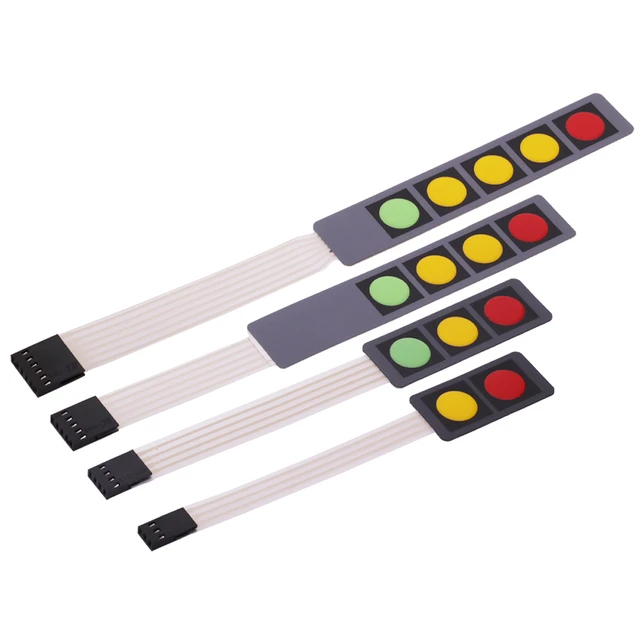Recognizing Membrane Layer Switches: The Secret to Sturdy and Reputable Controls

What Are Membrane Layer Buttons?
Membrane switches are an advanced option in the world of interface modern technology, incorporating functionality and style flawlessly. These devices offer as a user interface between individuals and digital systems, integrating several components into a small format. Normally created from adaptable, slim layers of products, membrane layer switches are developed to reply to touch, enabling users to interact with machinery and digital tools properly.
The key components of a membrane layer switch include a printed circuit layer, visuals overlay, and a spacer layer that protects against unplanned activation. The visuals overlay can be personalized to show brand identity or customer choices, improving aesthetics while ensuring use. Membrane layer switches are commonly made use of in numerous applications, including medical tools, customer electronics, and industrial tools, owing to their longevity and resistance to ecological elements such as moisture and dirt.
Among the essential advantages of membrane layer switches is their capacity to hold up against deterioration, making them perfect for high-traffic environments. In addition, they are lightweight and call for very little space, permitting ingenious designs in item advancement. In general, membrane layer changes represent a reliable and functional choice for contemporary electronic user interfaces, marrying modern technology with user-centric style concepts.
Exactly How Membrane Layer Changes Job
The operation of membrane layer changes joints on an easy yet effective system that converts individual input into digital signals. These buttons contain numerous layers, usually including a visuals overlay, a spacer layer, and a circuit layer. When a customer presses the switch, the leading layer warps, permitting a conductive element in the circuit layer to make call with a corresponding conductive pad on the bottom of the visuals overlay. This contact closes the circuit and sends out a digital signal to the device, indicating that the button has been triggered.
The layout of membrane layer buttons can differ, but they typically integrate domes or responsive components to provide feedback to the user, enhancing the general experience - membrane switch. The materials utilized in membrane layer buttons, such as polyester or polycarbonate, add to their longevity and resistance to ecological variables, consisting of dampness and dirt. Furthermore, the printed circuits are generally encapsulated, which protects them from wear and tear over time.
Advantages of Membrane Layer Buttons

Furthermore, membrane layer buttons are recognized for their durability. Constructed from robust materials, they are resistant to dust, moisture, and physical wear, which substantially expands their life-span contrasted to standard mechanical buttons. This toughness makes them specifically ideal for high-traffic settings and applications calling for long life.
An additional considerable advantage is the simplicity of cleaning and maintenance. The smooth surface of membrane layer switches minimizes dust buildup and is often unsusceptible spills, making them ideal for setups that call for regular sanitization.
Additionally, membrane switches supply a structured profile, resulting in a thinner design that can be incorporated right into different devices without adding mass. This function not only boosts the visual charm but additionally adds to a more ergonomic item style.
Applications of Membrane Buttons
Flexible and easy to use, membrane buttons discover applications across a variety of industries, consisting of medical devices, customer electronics, and commercial equipment. In the clinical field, these buttons are important to devices such as analysis equipment, find here person tracking systems, and mixture pumps, where dependability and ease of cleansing are crucial. Their capacity to preserve and withstand extreme environments capability makes them perfect for such applications.

In customer electronic devices, membrane buttons are made use of in products like microwaves, washing website here equipments, and remote controls - membrane switch. Their smooth layout enables user-friendly customer interfaces, enhancing the general customer experience while providing toughness and resistance to tear and wear
Commercial equipment also gains from membrane layer switches, especially in control panels for equipment and automation systems. These switches use defense against dust and wetness, making sure consistent performance in difficult atmospheres. Their customizable features allow manufacturers to tailor them to specific operational needs, enhancing efficiency and functionality.
Choosing the Right Membrane Switch Over
When selecting a membrane layer button, it is crucial to take into consideration numerous variables that affect efficiency and suitability for particular applications. The primary factors to consider consist of ecological conditions, tactile responses, durability, and layout requirements.
First, examine the operating atmosphere; switches revealed to dampness, chemicals, or extreme temperatures require details products to guarantee longevity and capability. Next off, assess the need for responsive comments. Depending on customer communication, some applications may gain from a responsive reaction to confirm activation, while others might like a non-tactile design for visual factors.
Resilience is another essential aspect; membrane buttons must be designed to withstand constant use, influences, and abrasion. Guarantee the picked switch can sustain the expected lifecycle, specifically in high-usage situations.

Verdict
In conclusion, membrane layer switches over serve as crucial components in the style of reliable and resilient control systems throughout numerous industries. The flexibility of membrane layer switches over allows for tailored options that fulfill details operational requirements, strengthening their value in modern technology.
Membrane changes stand for a critical aspect of modern interface style, mixing capability with strength in numerous applications.Membrane layer buttons are a sophisticated solution in the realm of user interface innovation, integrating performance and style effortlessly. Commonly created from adaptable, slim layers of products, membrane layer buttons are made to react to touch, making it possible for customers to engage with equipment and digital gadgets Find Out More efficiently.
The style of membrane switches can differ, yet they usually include domes or responsive aspects to supply comments to the individual, enhancing the overall experience.In verdict, membrane layer switches over offer as necessary elements in the style of resilient and dependable control systems across numerous sectors.
Comments on “Membrane Switch: A Comprehensive Guide to Its Uses and Applications”